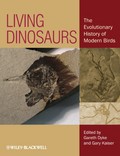Living Dinosaurs
The Evolutionary History of Modern Birds

1. Edition April 2011
440 Pages, Hardcover
Wiley & Sons Ltd
Short Description
This book explores the bio-molecular aspects of avian biology as well as the anatomy of dinosaurs. It bridges the gap between those who study bird fossils and those who study the living animals. The first section reviews the early ancestry of birds and the conditions under which they and their nearest relatives diversified in the Cretaceous. The second section provides ornithologists with an overview of the fossil record, and the third section focuses on the development of features that have contributed to the success of living forms.
Living Dinosaurs offers a snapshot of our current understanding of the origin and evolution of birds. After slumbering for more than a century, avian palaeontology has been awakened by startling new discoveries on almost every continent. Controversies about whether dinosaurs had real feathers or whether birds were related to dinosaurs have been swept away and replaced by new and more difficult questions: How old is the avian lineage? How did birds learn to fly? Which birds survived the great extinction that ended the Mesozoic Era and how did the avian genome evolve? Answers to these questions may help us understand how the different kinds of living birds are related to one another and how they evolved into their current niches. More importantly, they may help us understand what we need to do to help them survive the dramatic impacts of human activity on the planet.
List of Contributors.
Preface.
Part 1 Introduction: the Deep Evolutionary History of Modern Birds.
Introduction: Changing the Questions in Avian Paleontology (Gary Kaiser and Gareth Dyke).
1 Theropod Diversity and the Refinement of Avian Characteristics (Peter J. Makovicky and Lindsay E. Zanno).
2 Why Were There Dinosaurs? Why Are There Birds? (Peter Ward and Robert Berner).
3 Pre-modern Birds: Avian Divergences in the Mesozoic (Jingmai O'Connor, Luis M. Chiappe, and Alyssa Bell).
Part 2 "The Contribution of Paleontology to Ornithology": the Diversity of Modern Birds: Fossils and the Avian Tree of Life.
4 Progress and Obstacles in the Phylogenetics of Modern Birds (Bradley C. Livezey).
5 The Utility of Fossil Taxa and the Evolution of Modern Birds: Commentary and Analysis (Gareth Dyke and Eoin Gardiner).
6 Penguins Past, Present, and Future: Trends in the Evolution of the Sphenisciformes (Daniel T. Ksepka and Tatsuro Ando).
7 Phorusrhacids: the Terror Birds (Herculano Alvarenga, Luis Chiappe, and Sara Bertelli).
8 The Pseudo-toothed Birds (Aves, Odontopterygiformes) and their Bearing on the Early Evolution of Modern Birds (Estelle Bourdon).
9 Phylogeny and Diversification of Modern Passerines (F. Keith Barker).
Part 3 The Evolution of Key Avian Attributes.
10 Morphological and Behavioral Correlates of Flapping Flight (Bret W. Tobalske, Douglas R. Warrick, Brandon E. Jackson, and Kenneth P. Dial).
11 Evolution of the Avian Brain and Senses (Stig Walsh and Angela Milner).
12 Evolving Perceptions on the Antiquity of the Modern Avian Tree (Joseph W. Brown and M. Van Tuinen).
13 Major Events in Avian Genome Evolution (Chris L. Organ and Scott V. Edwards).
14 Bird Evolution Across the K-Pg Boundary and the Basal Neornithine Diversification (Bent E. K. Lindow).
15 Functional and Phylogenetic Diversity in Marine and Aquatic Birds (Gary Kaiser).
Part 4 The Future: Conservation and Climate Change.
16 The State of the World's Birds and the Future of Avian Diversity (Gavin H. Thomas).
Glossary.
Index.
Colour plates.
"No student in the field of bird history should be without this work. Additionally, this volume will inform those seriously interested in vertebrate evolution." (The Quarterly Review of Biology, 1 December 2012)
"In short, Living Dinosaurs is a most worthy and well crafted volume. Its strength is in providing a surprising number of really good reviews of many aspects of bird evolution and history, generally written by leading workers in the respective areas. I personally found the book highly useful in my own research and ended up citing many of its chapters in a recently published review of the avialan fossil record (Naish 2012)." (Scientific American, 26 August 2012)
"All in all, the book might be useful for those who wish to keep abreast of various aspects of avian evolution, especially specialists in the field and those with specific interests in the topics covered." (The Auk, 2012)
"Recommended. Upper-division undergraduates through professionals." (Choice, 1 November 2011)
"Living Dinosaurs offers a snapshot of our current understanding of the origin and evolution of birds . . . a must have for those with an interest in avian paleontology and/or systematics". (Guardian, 8 May 2011)
"In Living Dinosaurs: The Evolutionary History of Modern Birds, researchers Gareth Dyke and Gary Kaiser set out to unite ornithologists and paleontologists to form a modern understanding of the evolution of birds at the beginning of the 21st century." (Bioscience Technology Online, 5 April 2011)
Gary Kaiser worked as a field biologist in Canada's migratory bird program from 1968 until retirement in 1999. He specialized in the capture and tagging of birds, particularly seabirds but began to study avian evolution in 1995. He combined this new interest with knowleddge gained from handling birds to write Inner Bird in 2007. He has also contributed to Birds of British Columbia and Seabirds of the Russian Far East.


